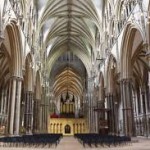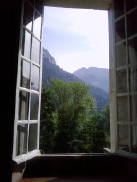In their March 22 issue, New Scientist reported on the recent detection of gravitational waves that are predicted by the inflationary theory in physics. This observation could help reveal details of what the cosmos was like “in the first slivers of a second” following the big bang. It supports the theory that implies the existence of an ever-expanding multiverse. There’s also a nice write up in the Guardian, which is free.
Lisa Grossman, the author of the report, followed up with a short piece (Medieval text about light held hints of a multiverse) describing a recent paper which explores the mathematical side of a 13th-century treatise on light written by Robert Grosseteste. This paper is one of the fruits of an interdisciplinary research project at Durham University, UK, which has been given the name The Ordered Universe. It’s core team of investigators includes Giles Gasper, from Durham’s Department of History, Tom McLeish from physics, Cecilia Panti from the University of Rome’s Department of Philosophy, and Hannah Smithson from the Department of Psychology at Pembroke College, University of Oxford, UK. This group along with Richard G. Bower, Brian Tanner and Neil Lewis, co-authored the paper in which Grosseteste’s treatise On Light (De luce) is reformulated in terms of modern mathematics. The authors conclude that Grosseteste’s ideas contain the prospect of the multiverse theories now being considered by cosmologists.
This kind of observation may help reveal something about the kinship between mathematics and thought itself. Grosseteste brought a conceptual order to non-mathematical thoughts. His own thoughts follow the patterns that he finds in his experience, in the thoughts of others, as well as in the very conceptual structures he considers. He follows the implications of the ideas he puts forward and then creatively interprets these implications.
Yet this non-mathematical order can accommodate the superpositioning of modern mathematics, out of which emerges something remarkably similar to contemporary theories in cosmology.
The abstract of the paper reads as follows:
In his treatise on light, written in about 1225, Robert Grosseteste describes a cosmological model in which the Universe is created in a big-bang like explosion and subsequent condensation. He postulates that the fundamental coupling of light and matter gives rises to the material body of the entire cosmos. Expansion is arrested when matter reaches a minimum density and subsequent emission of light from the outer region leads to compression and rarefaction of the inner bodily mass so as to create nine celestial spheres, with an imperfect residual core. In this paper we reformulate the Latin description in terms of a modern mathematical model. The equations which describe the coupling of light and matter are solved numerically, subject to initial conditions and critical criteria consistent with the text. Formation of a universe with a non-infinite number of perfected spheres is extremely sensitive to the initial conditions, the intensity of the light and the transparency of these spheres. In this “medieval multiverse”, only a small range of opacity and initial density profiles lead to a stable universe with nine perfected spheres. As in current cosmological thinking, the existence of Grosseteste’s universe relies on a very special combination of fundamental parameters.
It is this “very special combination of fundamental parameters,” where the nine-sphere universe depends on key initial conditions, that opens the door to a multiverse. Page two includes a careful description of the paper’s intent:
While it is crucial to avoid superposing a modern world view into Grosseteste’s thought, throughout his work there pervades an interest in the nature of the created world, the existence of order within it, the mechanisms whereby it is sustained and a search for unity of explanation. These ideas are common in medieval thinking; nonetheless the originality of Grosseteste was to think about unity, order and causal explanation of natural phenomena as being due to light, its properties and the mechanism by which we perceive it. …We are not trying to “correct” Grosseteste’s thinking in the light of modern physics, nor are we claiming Grosseteste’s ideas as a precedent for modern cosmological thinking. Rather, we are making a translation, not just from Latin into English but from the new critical Latin edition [9] and English translation [10] of his De luce into mathematical language. We aim to write down the equations, as he might have done had he access to modern mathematical and computational techniques, solve the equations numerically and explore the solutions. There are benefits here from both an historical and a scientific perspective. The application of mathematics and computation generate, as we shall see, a closer and more comprehensive examination of a medieval scientific text and the mind behind it. However, there are scientific benefits as well, as the medieval cosmos constitutes a quite novel arena to compute radiation/matter interactions and dynamics, and in which to discover new physical structure.
Grosseteste’s work builds on Aristotle’s idea that the earth is embedded in a series of nine concentric spheres that are the universe. Particularly striking, however, is Grosseteste’s idea that light is the “first corporeal form and that it multiplies itself infinitely.” He argued that light (luxe) expanded instantaneously from a point. For Grosseteste, this first corporeal form has no dimension and, since form and matter are inseparable, neither does matter. Only by its expansion into all directions does light introduce three dimensions into matter.
In the beginning of time, light extended matter, drawing it out along with itself into a sphere the size of the material universe.
Light drags matter outwards and so, Grosseteste concludes, the density of matter must decrease as its radius increases.
 But finding Grosseteste’s cosmology in the architecture of Lincoln Cathedral makes things even more interesting. John Shannon Hendrix at Roger Williams University does just that in his 2010 paper, “The Geometries of Robert Grosseteste and the Architecture of Lincoln Cathedral.”
But finding Grosseteste’s cosmology in the architecture of Lincoln Cathedral makes things even more interesting. John Shannon Hendrix at Roger Williams University does just that in his 2010 paper, “The Geometries of Robert Grosseteste and the Architecture of Lincoln Cathedral.”
…the geometries were similar enough to suggest that a cultural concept of a geometrical substructure of matter could be translated into the architectural forms of the cathedrals as catechisms of the structure of matter and being. The architecture of the cathedrals was intended to edify the viewer as to the underlying nature of being and as to the relation between the human intellect and nature and God.
…Geometries used by Grosseteste to describe the diffusion and rarefaction of light in the formation of matter can be compared to the peculiar geometries of the vaulting of Lincoln Cathedral, in the particular lines and line segments of the vaulting. Volumes formed by the reflection and refraction of light, as described by Grosseteste, can be compared to the volumes of the vaulting, in particular the concave and conical shapes. The lux, or spiritual light, and the lumen, or physical light, can be applied to the light in the cathedral, as shining through the stained glass windows and illuminating the geometries. (emphasis added)
The Stanford Encyclopedia of Philosophy makes the following statements about Grosseteste:
Under Augustine’s influence Grosseteste subscribes to an illuminationist account of human knowledge, according to which human knowledge is understood by analogy to bodily vision: as a body can only be seen if light is shed on it and the eyes, so something can only be known if a spiritual light is shed on it and the mind’s eye. Grosseteste presents versions of such an account in his treatise On Truth and in his commentary on the Posterior Analytics.
…But as we can only see a body as colored if an external light is shed on its color, rendering it actually visible to us, so in order for us to see a created thing as true, an external light must be shed on its truth, rendering it actually visible to us. (emphasis added)
What we have here are a series of overlapping metaphors, if you like, each trying to capture (sensorily and intellectually) our own human impression of our existence and our origin. It may be said that mathematics brings us most precisely (in the intellectual sense) to the beginning of things, but mathematics, in all of them, is used to build and to communicate meaning, bringing meaningful structure to remote light signals, as well as cathedral walls. That it can speak to us about ourselves in so diverse a manner again indicates its fundamental nature in human experience.


Recent Comments